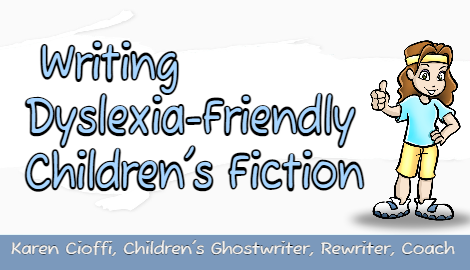Contributed by Aideen Mooney
As a retired primary school teacher, I am very experienced in teaching dyslexics. And now I am using my knowledge to learn how to write for them.
Let me share with you some of my discoveries and decisions.
When writing dyslexia-friendly books be aware of the following:
• Clarity of font.
• Left aligned text without justification, otherwise dyslexics can lose their place.
• Type of paper. Black print on white paper creates visual stress so coloured paper is better.
• A layout which creates lots of space.
• Shorter books, chapters, paragraphs, and sentences.
• Unpatronising content even though the reading level is lower.
• An edit to ensure easy comprehension.
• Use the active voice rather than the passive.
• Put the agent before the verb: …Anika shouted rather than …shouted Anika.
• Try and change adverbs into nouns or do away with the adverbs altogether. Instead of writing – she flung herself courageously across the window, write – with great courage she flung herself across the window. Or just, she flung herself across the window. It is obviously courageous.
• Leave out any parts that readers tend to skip. I made the mistake of including a preface in my first book which was unnecessary, makes the start slow and might be off-putting because it isn’t in the style of the rest of the novel.
Barrington Stoke publishes dyslexia-friendly books. The one I have is Queen of the Silver Arrow by Caroline Lawrence. It is historical teen fiction based on part of Virgil’s Aeneid. The paper is beautiful as it is heavy and off-white. A heavy paper tends to reduce glare. It is well-written but with short paragraphs and sentences and simple language, but it never seems dumbed down.
My friend Pete, who is a dyslexic/ADHD adult said, ‘I’ve always wondered why books have such long winded descriptions. It makes me feel frustrated and I start skipping bits.’
I make my descriptive passages as brief as possible, only giving the essentials but I also try to make them shine. I do the same with interior monologue. The reader only gets what they need to know, and I provide it in short bursts.
It is a given for writers that every sentence should either develop character or move the story forward. I am extra vigilant about applying this.
The easiest way to create space on a page is to use dialogue to develop character and plot. One of my beta readers, a boy aged 12, commented on my first book, ‘I thought the writing style was good. The story was simple to follow, and I liked that there was lots of speech, and it wasn’t too descriptive.’
Whenever I use one-sentence paragraphs or dialogue with only one-word exchanges, I feel that I am giving my readers rest breaks.
Short sentences are ideal for the dyslexic reader but as a teacher, I like to add the occasional longer one for reading development. I feel that as I haven’t stressed them out in the main body of the prose, I can challenge them every now and again. And it is the same with vocabulary. I use mostly simple, straight-forward words but like to add more unusual ones that they might be interested in.
My writing style takes inspiration from Ernest Hemingway. He broke the mould at a time when writers were piling adjective upon adjective. When I read Henry James I can lose track of the meaning halfway through a sentence. I guess that this is often the experience of the dyslexic reader. In contrast Hemmingway’s writing is terse and unadorned. He says as little as possible and he lets the characters speak and tell the story.
There is a Hemmingway App that you can use as an editor. It works by colour-coding your writing. Yellow sentences are long and structurally complex; red ones are confusing; purple words have a simpler alternative; blue words are adverbs; and green phrases indicate the use of the passive voice. It also gives a reading grade.
These suggestions make reading easier for the dyslexic. Their brains process words and the whole world in a different way, and it is this difference which is their strength. We need their creative, outside-the-box thinking, and so we need to help them succeed within our education systems. Let’s give them all the support we can.
ABOUT THE AUTHOR
Aideen is a retired primary school teacher living in the west of Ireland. She has self-published two eBooks for children as part of the Ballynoosle Series. They are A Strange Place and The Banshee and the Bees. Mermaid’s Blood will be out in the Autumn of 2024.
Aideen Mooney
BA; PGCE; MEd (Dyslexia & Special Needs)
ballynooslebooks@gmail.com

I’m a working children’s ghostwriter, rewriter, editor, and coach. I can help turn your story into a book you’ll be proud to be the author of, one that’s publishable and marketable.
OTHER HELP I OFFER:
HOW TO WRITE A CHILDREN’S FICTION BOOK
A DIY book to help you write your own children’s book.
PICTURE BOOK AND CHAPTER BOOK COACHING
Four to ten-week coaching programs.
WRITERS ON THE MOVE PRESS.
Self-publishing help for children’s authors.
You can contact me at: kcioffiventrice@gmail.com. Or give me a call at 347—834—6700. (Please leave a message- I’ll get back to you as soon as I can.)

